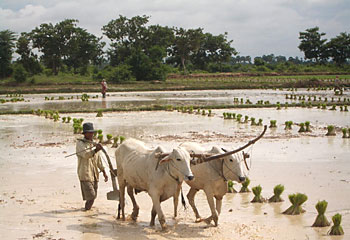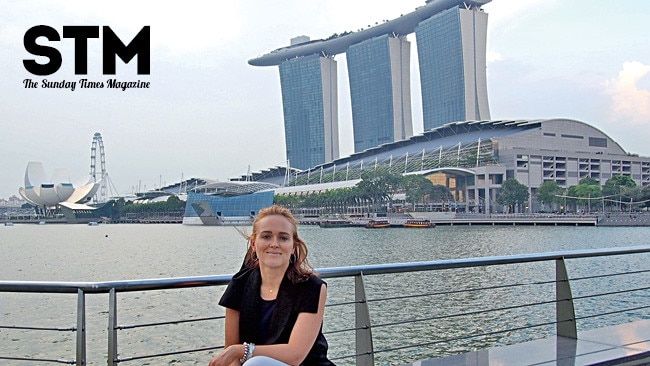Roll of the dice
IN a country ravaged by war, the people are smiling again, writes Mike O'Connor from the road less travelled by tourists in Cambodia.

THE water dripped from the tall ceiling, pooling on the floor of what once must have been the casino's grand ballroom.
At the top of the broad stone staircase, corridors led to the remains of suites with balconies which looked out across the gravelled forecourt. From the open roof garden there were views across to the lowlands from the 1100m plateau on which this eerie edifice stood.
For more than 40 years, Phnom Penh's elite gathered here, gambling in the luxurious surrounds of the Bokor Casino, built in the 1920s when the French tricolour ruled.
From a high point you could look down on the abandoned stone villas and the remains of a Catholic church. I stood there, aware of a drop in temperature, as clouds began to drift across the plateau, draping themselves around the orange lichen and lime-green moss covering the building.
The casino was abandoned in 1973, a victim of the country's violent past.
Cambodia has changed. It was about five years since I had visited, landing in Phnom Penh's then makeshift international airport, being driven to the centre of the capital along roads cratered by potholes.
Everywhere was evidence of the destruction by the Khmer Rouge during their four-year occupancy – buildings destroyed, streets torn up and stores levelled.
You could drink excellent Vietnamese coffee along the esplanade and look across the broad, brown expanse of the Tonle Sap River or lounge on the first floor bar of the waterfront Foreign Correspondents Club and drink Tiger beer.
You were aware, however, of a mood of quiet desperation. There had been too much war for far too long.
I travelled with a small group and on our first night, our guide told us that if we heard the odd shot we should ignore it but if we heard sustained automatic weapons fire, to get back to the hotel with all speed.
Since that time, Cambodians have moved on. The trickle of foreign investment has become a river and the people are smiling – they always did – but now you sense they have some reason to do so.
The road to the abandoned Bokor Casino had begun in the Elephant Bar of the Raffles Hotel Le Royal in Phnom Penh, built in 1929 and that city's most elegant colonial hotel.
Jackie Onassis enjoyed its marbled, five-star splendour and Somerset Maughan roamed its manicured gardens. It's that kind of place.
Traditional wisdom has it that you don't travel in Cambodia in the wet season as you tend to get wet.
So I was here, in the middle of the monsoon, having been told that to travel now would be to see the country through a different window, one which looked out on a countryside enriched by the rains.
We headed south through the outskirts of the city, past the factories where Cambodians worked making garments for Gap and Levi Strauss.
We were headed for southern Cambodia on the road less travelled from Phnom Penh along the coastline to Sihanoukville instead of the inland highway that links the two cities.
Within half an hour of leaving the city, the vista of paddy fields and distant palms began to unfold.
Oxen and water buffalo hauled wooden, steel-tipped ploughs through the glutinous mud of the flooded fields as women bent double to plant the new season's rice crop.
We were bound for Kep, a seaside town to which Phnom Penh's elite once flocked and the scene of vicious fighting between the Khmer Rouge and the Vietnamese Army.
Kep is undergoing a renaissance and the Phnom Penh residents are now making the three-hour drive to spend their weekends there.
The beach is small and indifferent and with a storm threatening and the waters of the Gulf of Thailand uninviting, seaside frolics did not appeal.
We headed instead to the thatched-roof bar of the small, newly built resort where we were to spend the night, later walking a few hundred metres down the road for dinner in a dirt-floored restaurant complete with skeletal dog and dishevelled children – pepper prawns, chilli chicken and grilled squid – and the bill was less than $A15.
On the outskirts of Kep we found one of those mad incongruities that travel unearths – Knai Bang Chatt.
It is a resort consisting of three brightly coloured Art Deco-style houses built by two Belgian gay men on a sprawling beachfront block. There is a large open-sided dining pavilion, a bar, a swimming pool and carefully tended tropical gardens and grounds and canopied double beds set by the water's edge for those who care to have an afternoon doze.
The furniture in the houses, in which every room has a sea view, consists of genuine 1930s period pieces with Khmer elements, and the place reeks of Euro taste and decorator style. It also reeks of under-use as the Belgians let it only to those few groups who are prepared to rent the entire property.
They lose money, but they don't care. They have plenty. C'est la vie.
We headed to Kampot the next morning, an appealing coastal town astride the Pristine River, Kampot being famous locally for its peppercorns.
Non-pepper aficionados are more likely to be taken with its fading, colonial architecture, riverside serenity and excellent, cheap restaurants.
There's a feeling of "old", pre-trauma Cambodia in the town.
It was from Kampot that we had made the ascent to Bokor Casino, a three-hour bruising, bone-jarring ride in a four-wheel-drive up the ruined, rutted road that led from the coast to that remnant of glories past and from Kampot that we left for our last stop – Sihanoukville.
As we departed Kampot I looked for the hundredth time at the grey sky splashed with patches of blue. The biblical inundation of which I had been warned had not so far come to pass. Perhaps I'd been lucky.
Sihanoukville did not come into being until 1955, built as a port by the Russians.
It remains the maritime hub but has also become a seaside resort, a poor man's Phuket, if you like.
It has good white sand beaches lined with sand-floored restaurants and bars where you can lounge and drink and be tempted to give a handful of coins to the child beggars who beseech you with outstretched palm.
What the town lacks is the soul and spirit of Kampot and it will undergo further commercial development next year when the airport is re-opened with a longer runway capable of carrying larger aircraft.
This will allow cruise ship passengers to avoid the tedious 160km bus ride for day trips to Phnom Penh and inbound travellers to Phnom Penh to spend a few nights at the beach at Sihanoukville before flying on to the temple complexes of Angkor Wat outside Siem Riep.
My memory of Sihanoukville is of the five-star Sokha Beach Hotel where I spent one night in what I suspect was the honeymoon suite.
We completed our five-day circle the next day, returning to Phnom Penh along a highway recently reconstructed by the Americans. It was once rutted and potholed but is now a tollway.
The Americans built it for no charge. I was told that the Cambodian Government promptly sold it to one of its powerful supporters who then erected toll booths, so the people are now forced to pay to travel on a road given to them as a gift from the Americans.
In Cambodia, some things never change.
The writer travelled as a guest of Travel Indochina, which has its own offices in Cambodia.



